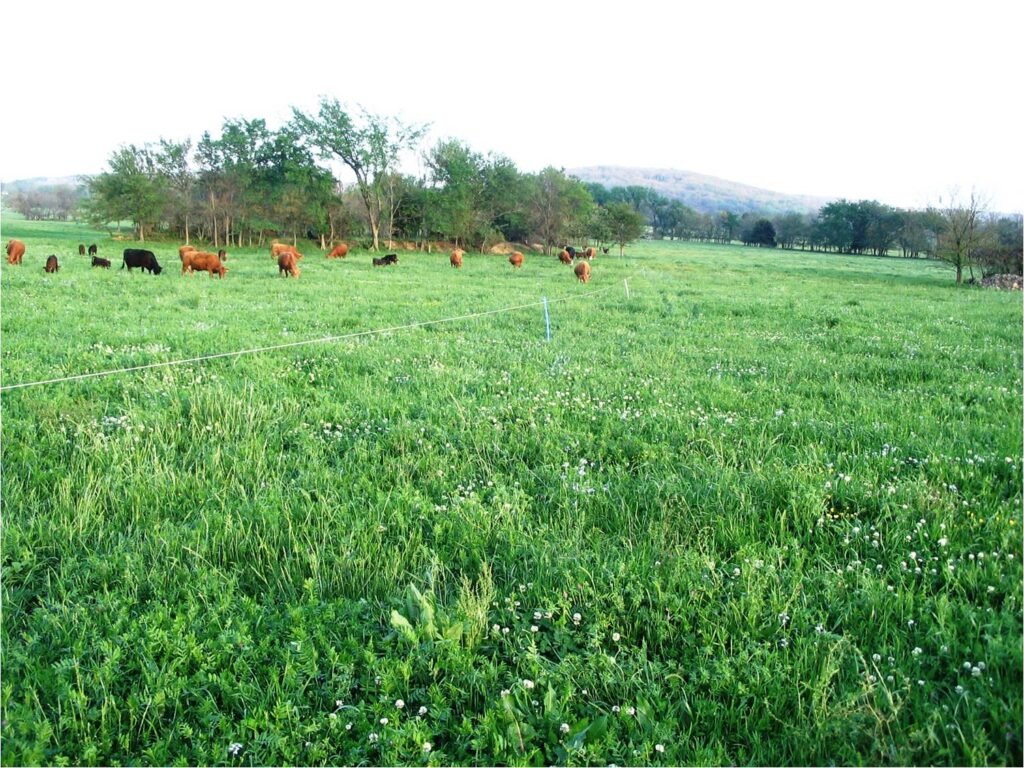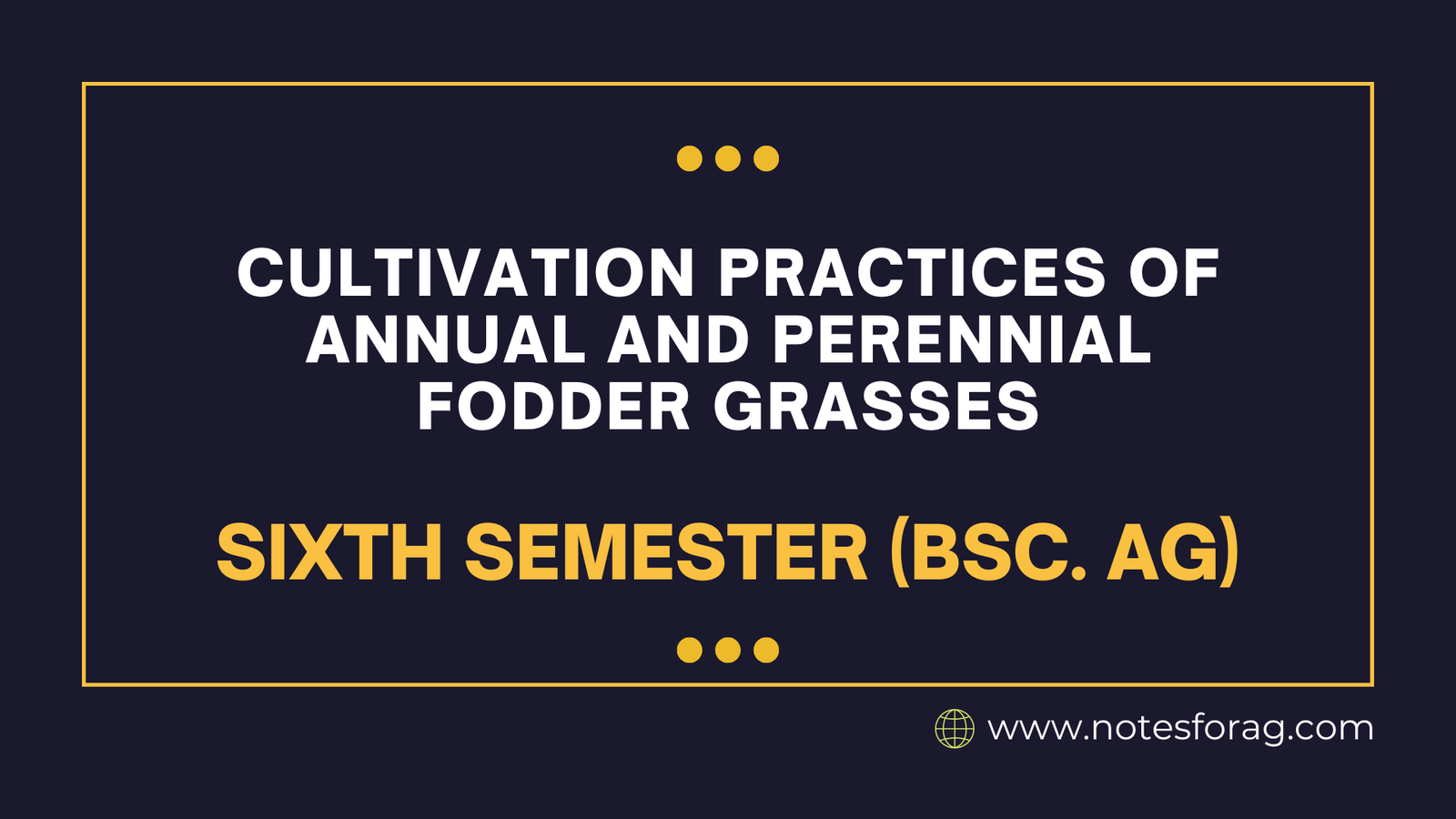Cultivating Annual and Perennial Fodder Grasses is essential for livestock feeding, as they provide a continuous supply of green forage throughout the year.
Table of Contents
Annual and Perennial Fodder Grasses
Annual fodder grasses are plants that complete their whole life cycle — from germination to seed production and death — in a single growing season, which usually lasts a few months. These grasses are sown annually and supply high-quality fodder during specified seasons. Once harvested or grazed, they do not regenerate and must be replanted.
Perennial fodder grasses exist over several years and regenerate after each harvest or grazing season, eliminating the need for replanting. These grasses produce a strong root structure, allowing them to regenerate year after year. They provide long-term feed production and can be harvested several times per year.

Here’s a brief overview of the cultivation practices for both annual and perennial fodder grasses:
Annual Fodder Grasses:
These grasses grow, flower, and complete their life cycle within one year. They are typically used for short-term forage production.
- Sorghum (Sorghum bicolor):
- Sowing Time: Summer (March to June).
- Soil: Well-drained loamy soil.
- Sowing Method: Broadcast or drill sowing.
- Seed Rate: 40-50 kg/ha.
- Irrigation: Requires frequent irrigation, especially during dry spells.
- Fertilization: Apply 60-80 kg nitrogen and 40-50 kg phosphorus per hectare.
- Harvesting: Harvest at 50% flowering stage for best nutritional quality.
- Maize (Zea mays):
- Sowing Time: Summer and rainy seasons.
- Soil: Well-drained fertile soils.
- Sowing Method: Line sowing with a spacing of 30 cm between plants and 75 cm between rows.
- Seed Rate: 30-40 kg/ha.
- Irrigation: Requires regular irrigation, particularly during dry periods.
- Fertilization: Apply 100 kg nitrogen, 40 kg phosphorus, and 20 kg potash per hectare.
- Harvesting: Harvest at the milky dough stage.
- Pearl Millet (Pennisetum glaucum):
- Sowing Time: Summer (April to June).
- Soil: Grows well in sandy loam to clay soils.
- Sowing Method: Line sowing or broadcasting.
- Seed Rate: 20-25 kg/ha.
- Irrigation: Moderate water requirement.
- Fertilization: Apply nitrogen (60-80 kg) and phosphorus (40-50 kg) per hectare.
- Harvesting: Cut at 50-60 days after sowing when plants reach 1.5-2 meters.
Perennial Fodder Grasses:
These grasses continue to grow for several years, providing sustained forage production.
- Napier Grass (Pennisetum purpureum):
- Planting Time: Any time of the year, but best in the rainy season.
- Soil: Well-drained, fertile soils.
- Planting Method: Plant stem cuttings or root splits.
- Spacing: 60-90 cm between rows and 50-60 cm between plants.
- Irrigation: Requires regular watering.
- Fertilization: Apply 100 kg nitrogen and 40-50 kg phosphorus per hectare.
- Harvesting: First cut at 45-60 days after planting; subsequent cuts every 40-45 days.
- Guinea Grass (Panicum maximum):
- Planting Time: Preferably at the onset of the rainy season.
- Soil: Grows in a variety of soils but prefers well-drained soils.
- Planting Method: Sown using seeds or root splits.
- Spacing: 40-60 cm between rows and 25-30 cm between plants.
- Irrigation: Moderate water requirements.
- Fertilization: 50-60 kg nitrogen and 30-40 kg phosphorus per hectare.
- Harvesting: First harvest 60-75 days after planting; subsequent cuts every 40-60 days.
- Buffel Grass (Cenchrus ciliaris):
- Planting Time: At the beginning of the rainy season.
- Soil: Performs best in light to medium textured soils.
- Planting Method: Direct seeding or transplanting of root slips.
- Spacing: 60-90 cm between rows.
- Irrigation: Drought-tolerant but responds well to irrigation.
- Fertilization: Apply nitrogen (40-60 kg) and phosphorus (20-30 kg) per hectare.
- Harvesting: Harvest 90-120 days after planting.
General Cultivation Tips:
- Weed Control: Regular weeding is crucial, especially in the early stages, to prevent competition for nutrients and water.
- Grazing Management: Avoid overgrazing to allow the grass to regenerate and provide continuous forage.
- Fertilization: Regular application of nitrogen-based fertilizers after every cut enhances regrowth and productivity.
By following these practices, Annual and Perennial Fodder Grasses can provide high-quality forage to support livestock feeding throughout the year.
Here’s a brief overview of the other cultivation practices for the mentioned Annual and Perennial Fodder Grasses:
1. Oats (Avena sativa):
- Type: Annual
- Sowing Time: Winter (October to November).
- Soil: Loamy or well-drained soils with good fertility.
- Sowing Method: Line sowing or broadcasting.
- Seed Rate: 80-100 kg/ha.
- Irrigation: Requires irrigation at regular intervals; 4-5 irrigations during the crop cycle.
- Fertilization: Apply 80-100 kg nitrogen and 40-50 kg phosphorus per hectare.
- Harvesting: Harvest at 50% flowering for optimal nutrient value.
2. Jawar (Sorghum bicolor) (Sorghum):
- Type: Annual
- Sowing Time: Summer (March to June) and rainy seasons.
- Soil: Well-drained loamy soil.
- Sowing Method: Broadcast or drill sowing.
- Seed Rate: 40-50 kg/ha.
- Irrigation: Requires frequent irrigation, especially in dry spells.
- Fertilization: Apply 60-80 kg nitrogen and 40-50 kg phosphorus per hectare.
- Harvesting: Cut at 50% flowering stage.
3. Bajar (Pearl Millet – Pennisetum glaucum):
- Type: Annual
- Sowing Time: Summer (April to June).
- Soil: Sandy loam to clay soils.
- Sowing Method: Line sowing or broadcasting.
- Seed Rate: 20-25 kg/ha.
- Irrigation: Moderate water requirement.
- Fertilization: Apply nitrogen (60-80 kg) and phosphorus (40-50 kg) per hectare.
- Harvesting: Cut 50-60 days after sowing when the plant reaches 1.5-2 meters.
4. Teosinte (Zea mexicana):
- Type: Annual
- Sowing Time: Summer season.
- Soil: Well-drained fertile soils.
- Sowing Method: Line sowing or broadcasting.
- Seed Rate: 40-50 kg/ha.
- Irrigation: Regular irrigation.
- Fertilization: Apply nitrogen (80-100 kg) and phosphorus (40-50 kg) per hectare.
- Harvesting: Harvest when the plant reaches 50-75% flowering.
5. Maize (Zea mays):
- Type: Annual
- Sowing Time: Summer and rainy seasons.
- Soil: Well-drained fertile soils.
- Sowing Method: Line sowing with spacing of 30 cm between plants and 75 cm between rows.
- Seed Rate: 30-40 kg/ha.
- Irrigation: Requires regular irrigation.
- Fertilization: Apply 100 kg nitrogen, 40 kg phosphorus, and 20 kg potash per hectare.
- Harvesting: Harvest at the milky dough stage.
6. Napier Grass (Pennisetum purpureum):
- Type: Perennial
- Planting Time: Best during the rainy season.
- Soil: Fertile, well-drained soils.
- Planting Method: Plant stem cuttings or root splits.
- Spacing: 60-90 cm between rows and 50-60 cm between plants.
- Irrigation: Requires frequent watering.
- Fertilization: Apply 100 kg nitrogen and 40-50 kg phosphorus per hectare.
- Harvesting: First cut at 45-60 days, subsequent cuts every 40-45 days.
7. Blue Panic (Panicum antidotale):
- Type: Perennial
- Planting Time: Early monsoon or spring.
- Soil: Light to medium-textured soils.
- Planting Method: Direct seeding or transplanting root slips.
- Spacing: 60-90 cm between rows.
- Irrigation: Moderate water requirement.
- Fertilization: Apply nitrogen (40-60 kg) and phosphorus (20-30 kg) per hectare.
- Harvesting: Harvest 90-120 days after planting.
8. Molasses Grass (Melinis minutiflora):
- Type: Perennial
- Planting Time: Best during the rainy season.
- Soil: Adapted to poor, sandy soils but grows best in fertile soils.
- Sowing Method: Broadcasting or planting root slips.
- Irrigation: Tolerant of low water conditions but performs better with moderate irrigation.
- Fertilization: Apply 40-60 kg nitrogen and 20-30 kg phosphorus per hectare.
- Harvesting: Harvest every 60-80 days.
9. Mulato Grass (Brachiaria hybrid):
- Type: Perennial
- Planting Time: Best in the rainy season.
- Soil: Grows well in most soil types, particularly loamy soils.
- Sowing Method: Broadcasting or planting root slips.
- Irrigation: Requires moderate irrigation.
- Fertilization: Apply nitrogen (40-60 kg) and phosphorus (20-30 kg) per hectare.
- Harvesting: Harvest every 50-70 days depending on growth.
10. Para Grass (Brachiaria mutica):
- Type: Perennial
- Planting Time: Best in the rainy season.
- Soil: Waterlogged areas or poorly drained soils.
- Planting Method: Plant stem cuttings or root splits.
- Spacing: 50-70 cm between rows.
- Irrigation: Grows well in moist and waterlogged areas; regular irrigation is needed.
- Fertilization: Apply 80-100 kg nitrogen and 40-50 kg phosphorus per hectare.
- Harvesting: First harvest at 60-75 days; subsequent cuts every 45-60 days.
11. Signal Grass (Brachiaria decumbens):
- Type: Perennial
- Planting Time: Best at the onset of the rainy season.
- Soil: Adaptable to a wide range of soils but prefers well-drained soils.
- Planting Method: Direct seeding or root slips.
- Spacing: 40-60 cm between rows.
- Irrigation: Drought-resistant but responds well to irrigation.
- Fertilization: Apply nitrogen (40-60 kg) and phosphorus (20-30 kg) per hectare.
- Harvesting: Harvest 70-90 days after planting.
These Annual and Perennial Fodder Grasses are chosen based on climate, soil type, and livestock needs. Proper irrigation, fertilization, and timely harvesting are key to maintaining high-quality fodder production.
Frequently Asked Questions (FAQs)
How to cultivate fodder?
In a fodder system, a grain like barley, wheat or oats is sprouted in plastic trays and allowed to grow for seven days and then fed to livestock.
What is grass fodder?
Fodder crops, on the other hand, are crops grown particularly to use as livestock feed, allowing the livestock owner to control the animals’ food intake.
Related Articles

